In modern interior design, recessed ceiling or also known as dropped ceiling has become increasingly popular due to its practical benefits and aesthetic appeal. Recessed ceiling is a type of false ceiling that is suspended beneath the main ceiling, creating an attractive layered look that has a lot of potential for design creativity. In this article, we will explore the many advantages of incorporating recessed ceiling in modern interior design.
Advantages of Recessed Ceiling
1. Concealment of Electrical Wiring and Plumbing
One of the main advantages of recessed ceiling is that it can cleverly conceal unsightly electrical wiring and plumbing, making a room look more streamlined and neater. Electrical wiring and plumbing are necessary elements in most buildings, but they can be quite unsightly and can detract from the overall aesthetics of a room. With recessed ceiling, you can neatly hide these elements away while still having easy access to them whenever needed.
2. Aesthetically Pleasing
Recessed ceiling can also be used to create a visually appealing focal point in a room. By using different colors, textures, and patterns, recessed ceiling can transform a plain ceiling into a work of art. Lighting fixtures can also be installed within recessed ceiling, adding to the overall ambiance of the room.
3. Improved Acoustics
Another advantage of recessed ceiling is that it can improve the acoustics in a room. The space between the main ceiling and the dropped ceiling acts as a buffer, absorbing sound waves and reducing echoes. Recessed ceiling can also be designed with acoustic tiles or panels, further improving the sound quality of a room.
4. Energy Efficiency
Recessed ceiling can also contribute to energy efficiency in a building. By installing insulation materials within the space between the main ceiling and the dropped ceiling, it can help to reduce heat loss in colder climates and improve cooling efficiency in warmer climates. This can help to reduce energy costs and create a more comfortable environment for occupants.
Types of Recessed Ceiling
1. Drywall Recessed Ceiling
Drywall recessed ceiling consists of a frame made of metal or wood attached to the main ceiling, with drywall panels installed within the frame. The panels can be painted, textured, or finished with materials such as wallpaper or fabric.
2. Suspended Ceiling
Suspended ceiling is a type of drywall recessed ceiling that uses a metal grid system to support ceiling tiles or panels. This type of recessed ceiling is commonly used in commercial buildings, as it provides easy access to concealed wiring and plumbing.
3. Coffer Ceiling
Coffer ceiling is a type of recessed ceiling that features recessed or raised panels in a grid pattern, creating a textured look. This type of recessed ceiling is often used to add a touch of elegance to formal dining rooms or living areas.
Recessed ceiling is a versatile and practical element that can greatly enhance the aesthetics and functionality of modern interior design. By concealing unsightly wiring and plumbing, creating a focal point, improving acoustics, and contributing to energy efficiency, recessed ceiling can benefit both commercial and residential buildings. With the variety of types and designs available, recessed ceiling can be customized to fit any style or need.




